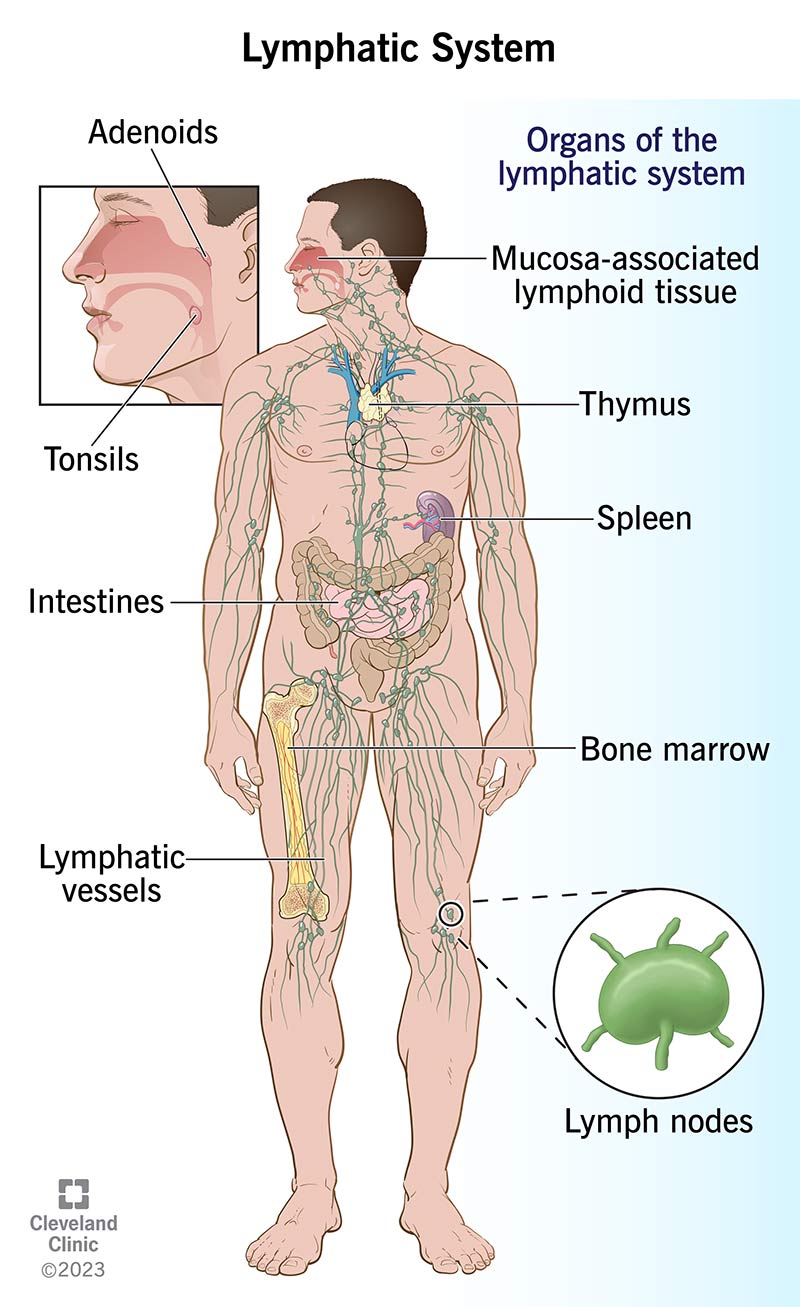Your lymphatic system is a group of organs, vessels and tissues that protect you from infection and keep a healthy balance of fluids throughout your body. Lymphatic system organs include your bone marrow, thymus and lymph nodes. Swollen lymph nodes are a sign of common infections, like strep throat, but also more serious diseases like cancer.
Advertisement
Cleveland Clinic is a non-profit academic medical center. Advertising on our site helps support our mission. We do not endorse non-Cleveland Clinic products or services. Policy
Your lymphatic system is a network of organs, vessels and tissues that work together to move a colorless, watery fluid (lymph) back into your circulatory system (your bloodstream).
Advertisement
Cleveland Clinic is a non-profit academic medical center. Advertising on our site helps support our mission. We do not endorse non-Cleveland Clinic products or services. Policy
As a vital part of your immune system, your lymphatic system protects you from infection and destroys old or abnormal cells your body doesn’t need. Lymphatic system functions also include maintaining normal fluid levels in your body and absorbing fats and fat-soluble vitamins so they can make their way into your bloodstream.
Your lymphatic system has many functions. Its key functions include:
Advertisement
Every day, about 20 liters of plasma (the liquid part of your blood) flow out of tiny pores in the thin walls of your capillaries. Imagine water seeping out of a sponge. Where does this liquid go? It delivers oxygen and nutrients to the tissues surrounding each capillary. The tissues hungrily soak up all the nutrients while leaving behind waste (like a kid who finishes their food but leaves behind a pile of sticky napkins).
The plasma doesn’t mind cleaning up the mess — it picks up the waste and then returns to your bloodstream the same way it came, by flowing back through the pores in your capillary walls. Each day, about 17 liters of plasma return to your bloodstream in this way. Since 20 liters initially flowed out of your capillary walls, that means 3 liters are still roaming around in your body’s tissues.
That’s where your lymphatic system steps in. Tiny lymphatic capillaries pick up this remaining fluid from your tissues. The fluid changed its name during its journey: now instead of plasma, it’s called lymph. Your lymphatic capillaries move the lymph into larger tubes called lymphatic vessels.
These vessels keep the lymph moving until it ultimately reaches one of two major ducts in your upper chest. These are called your right lymphatic duct and thoracic duct, and they’re a bit like highway on-ramps. They merge into large veins called your subclavian veins and empty the lymph into them. From there, your lymph reenters your bloodstream and can flow through your body again.

The organs of the lymphatic system are your:
Advertisement
Your lymphatic system is a big team. Other key players include your:
Advertisement
Many conditions can affect the various parts of your lymphatic system. Some happen during development before birth or during childhood. Others develop as a result of disease or injury. Some common diseases and disorders of the lymphatic system include:
Advertisement
Other disorders include:
To see if your lymphatic system is working as it should, your provider may use imaging tests like a computed tomography (CT) scan or magnetic resonance imaging (MRI). Your provider will tell you the test results and what they mean for you.
To keep your lymphatic system strong and healthy, you should:
Call a healthcare provider if you have:
When you see a diagram of the human body, your eyes might immediately go to the large organs like your heart or brain, or the red lines showing your arteries. But just as important are the lines that aren’t always shown on such diagrams — like the intricate network of tiny tubes that carry lymph throughout your body. Like roads that run side by side around a city, your blood vessels and lymph vessels wind around every corner of your body to deliver supplies and perform other vital jobs that keep you going strong.
Many different disorders can affect your lymphatic system and disrupt its daily work. If you’ve been diagnosed with such a condition, you may feel overwhelmed or scared about what it means for your future. Learning more about your lymphatic system and how it works can help you understand what’s happening inside your body and how treatment can help. Ask your healthcare provider for further resources on your lymphatic system and the specific condition you have.
Cleveland Clinic’s primary care providers offer lifelong medical care. From sinus infections and high blood pressure to preventive screening, we’re here for you.

Last reviewed on 07/31/2023.
Learn more about the Health Library and our editorial process.